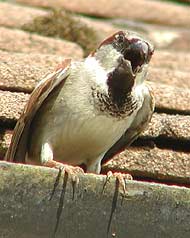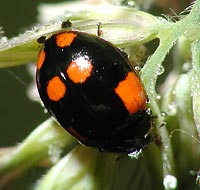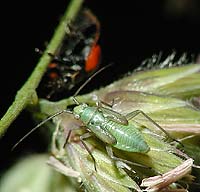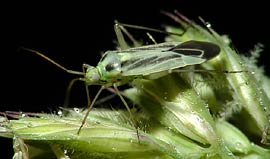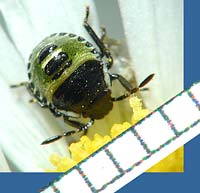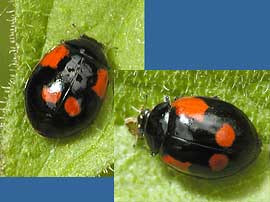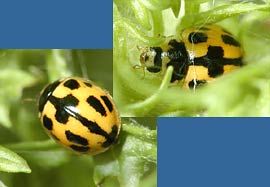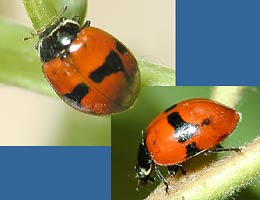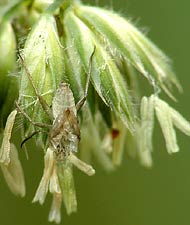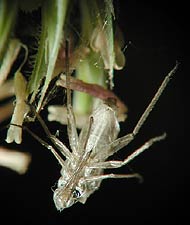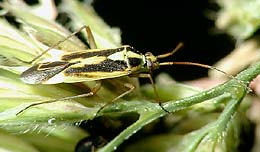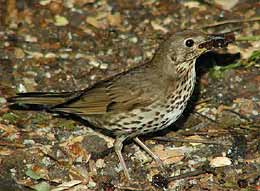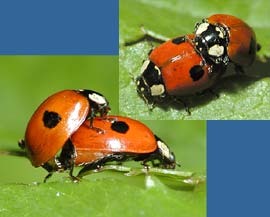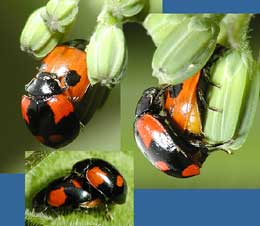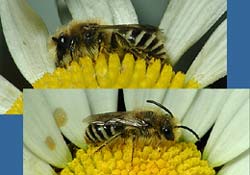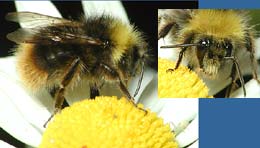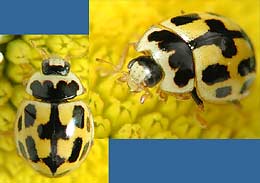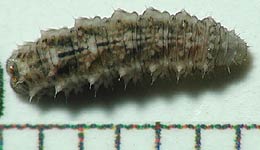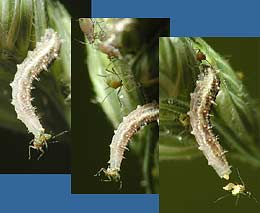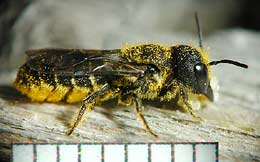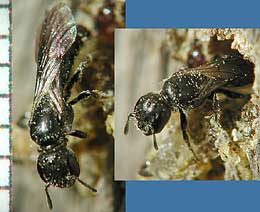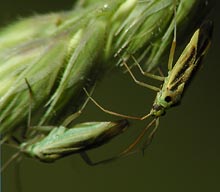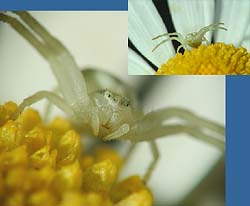Go to latest entry.....................................Go to previous entry
The bird activity goes on in its quite subdued way, although there was a 'new' Starling fledgling begging for food. Most of the noise was provided by the Sparrows, with the male I last photographed on 6 June still trying in vain to attract a mate to one of the nest boxes. He spends long periods at or near the boxes, calling loudly and displaying by crouching and spreading his wings in this drooped way. If he doesn't succeed soon I may get on with the job of replacing the old guttering that he is perching on in this image as I would like to get it finished before July.
Another variant of the 2-spot Ladybird turned up this evening, on grass growing by the big pond. There was also a 'normal' version nearby.
As I tried to get the Ladybird picture, this insect nymph appeared on the same group of flower heads. Its general shape suggests that it is a young capsid bug, although I can't be certain about this. It measures about 5mm in length (excluding antennae).
At 10.15pm I had another look at the grass and saw a couple more of the nymphs, but also this adult bug which looks as though it could be of the same type. A look in my insect guides suggests that it could be Stenotus binotatus, a capsid bug which feeds largely on the flower heads of grasses.
I spotted two of these nymphs today, one on grass, and this one on an Oxeye Daisy. It measures about 3mm long and I think it is one of the Shield Bugs, but I can't tell which one.
17 June - This morning has been much more overcast, but still warm (25C at 1.30pm). There was no sign of Sparrow activity near the boxes this morning so I have taken a bit of a gamble and moved them around the corner in to our shared driveway. I shall watch to see if our vocalist finds them again quickly! Looking more closely at the grass flower heads has revealed several more of the capsid bugs I photographed yesterday.
Some more ladybirds have appeared today. These two, on the same plant, are almost identical variants on the 2-spot Ladybird, but having two less spots than the one pictured yesterday.
This one was a real problem to photograph as it dashed around amongst the intricate leaves of one of the Ragwort plant that are near to flowering. It's a variant of the 14-spot ladybird (Propylea 14-punctata). These can be anywhere from nearly all yellow to nearly all black in colour as the black spots merge.
A third one to add this evening, and (I assume) another 2-spot Ladybird variant!
My last pictures for the day are again about the capsid bug Stenotus binotatus. There are numerous nymphs on the grass flower heads, so I spent a bit of time searching for moults this afternoon.
Here is one of the moults I found. Its legs are still grasping the grass, and you can see the shape of the deleloping wings. The moult is split open at the head end.
This is a second moult, seen from the other side. You can see how the antennae have been folded down against the body. I find it amazing how the insect literally climbs out of its own skin in this way!
Sticking with the same bug for one more (rather over-exposed) photograph - this time of a male Stenotus binotatus which turns orange and black as it gets older.
It has obviously got offspring as it took away a beakful of raisins, and then came back several more times. This is a sight I haven't seen for a long time - I hope it is a good sign for our local Thrush population.
Coincidentally, the female Blackbird turned up just afterwards to feed and, for the first time for several weeks she wasn't interested in taking food away. I know there is at least one Blackbird juvenile about, but since I was able to get a snatched picture at the beginning of the month it has proved too elusive to photograph since. While on that theme, the Blue Tits are now completely absent from the garden. It must be a week since I saw one here and I have not seen or heard any signs of any young ones.
A check of the plants this morning didn't reveal any 'new' ladybird variants, although I did see half a dozen of the standard 2-spot ladybirds, including this mating pair.
Later in the morning this pair of very different looking Ladybirds were mating in a very precarious position on Nipplewort flower buds (the top two images). This pairing confirms that the mainly black male is indeed a 2-spot Ladybird variant. The lower image shows another variant pair mating this afternoon. Now I shall have to watch out for the egg laying!
Today the weather was disappointing, with the temperature down below 20C all day under overcast skies and with a strong breeze.
They are frequent daytime visitors to the daisies, but at 10pm this evening these two are tucked up (for the night?) against the centres of two Ox-eye Daisies. This is something I haven't seen before. There is very little protection for them, especially if it rains tonight.
Similarly, this very lethargic bumble bee, side on to the east, seemed to be waiting for the sun to appear. You may just make out a tiny crab spider peeing out from between the daisy petals. When adult, these spiders will tackle bumble bees. The Ox-eye Daisies are a magnet for insects and this morning is no exception, with another 14-spot ladybird variant turning up. Scroll up to compare it with the one I pictured two days ago. This last week has brought a wide variety of individuals, even if overall ladybird numbers are still low so far.
The Song Thrush has been taking away food again this morning, and we have had more fledgling Sparrows being fed. Our vocalist male House Sparrow has rediscovered the nestboxes in their new position and has recommenced his efforts to attract that elusive partner! The male Chaffinch has got quite used to us sitting just a few feet away as he visits the bird table and this afternoon I realised that, after eating a bit himself he was definitely taking sunflower seeds away to feed either his partner or his offspring. The female only appears occasionally and I have only seen her here once today. The capsid bugs on the grass seem to be dong well, but there are other greatures there as well, including the inevitable aphids and several larvae. The larvae are about 6mm long when at rest, but as they move about in a leach-like fashion they stretch to over 10mm. I believe they are hoverfly larvae (Syrphus sp.).
This afternoon I spotted this one hanging from a grass flower head, and on closer inspection found that it had caught a small aphid. When the left hand picture was taken the aphid(?) was still moving. It was another eight minutes before the right hand image was taken as the remains were discarded.
As I watched the bees today I spotted a couple of these even smaller individuals visiting the smallest of the holes in the bee hotel. As the scale shows, they are between 5-6mm long, and the hole the bee is reversing into is less than 3mm wide. The different colour pollen on the two bees shows that they have been visiting different flower species.
The male (on the right) would gingerly lower his antennae until they touched the hind legs of the female. She shook and he withdrew the antennae. This was repeated a number of times, but then the female just walked off! I shall have to watch out for this behaviour again.
Unfortunately I couldn't get an image where both bugs were in focus. There are now a couple of these crab spiders on the Ox-eye Daisies. They are still very small, this one measuring less than 1cm across its outstretched legs. In the bright daylight t is very sensitive to my movements near the daisy and usually dashed under the petals when I approach. However, once the light levels started to drop this evening I was able to get close enough to take a couple of low level images from a potential victim's point of view. |
|
